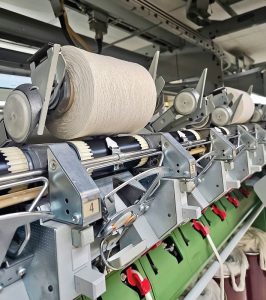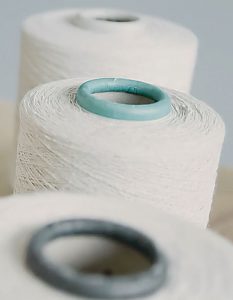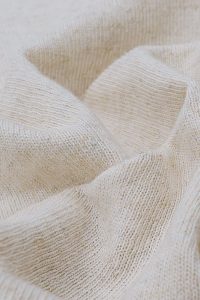
(Image courtesy of U.S. Department of Agriculture Agricultural Research Service, New Orleans)
Will uncertainty in global supply chains created by tariffs create opportunities for hemp in the textile industry?
By Aaron Nesser
China has long dominated hemp textiles. It is the number one grower and processor.
Since industrial hemp’s legalization in 2018, the United States has become the world’s third-largest grower of hemp, but China still dominates the critical process of converting raw hemp into textile fiber.
This dynamic means that some U.S.-grown hemp is shipped to China for processing before it is incorporated into apparel destined for U.S. and European markets — a complex global loop that new tariffs, even at just 30 percent, are now disrupting.
Why Now? Positioning For A Shifting Market
Hemp is hardly new to American soil; it was once the number one fiber crop grown in the United States, essential for industries like shipping, defense, textiles and paper. However, shifts in technology and policy, including its later prohibition, pushed it aside.
The 2018 Farm Bill brought a resurgence of interest, but the initial hype quickly met reality. Farmers rushed to grow hemp, but with limited processing infrastructure, there were few buyers, and many growers got burned.
Since then, companies have quietly built the needed infrastructure, processing U.S.-grown hemp into products like insulation and building materials.
Why might this tariff-driven moment differ? Key parts of the supply chain are now in place. More farmers are growing industrial hemp, and volume processors like Dallas-based Panda Biotech LLC and IND Hemp, Benton, Mont., are contracting directly with farmers to ensure a plentiful supply of hemp materials, including the key raw ingredient for textile fiber.
From Missed Expectations To Real Resilience
During hemp’s hype-phase from 2018–2022, hopes ran high that it could be a superior, sustainable substitute for cotton. However, early attempts to produce hemp textiles revealed significant challenges. One-hundred-percent hemp yarns failed in existing cotton mills, blends with cotton were less than ideal, and the “cottonization” process proved more complex and environmentally taxing than anticipated.
But the industry has learned from these early stumbles. After a period of recalibration, hemp now is getting beyond some of the early roadblocks and shows potential for clear economic, environmental and performance advantages.
As a crop, hemp is very productive. Compared to cotton it produces three to four times as much fiber per acre, according to the U.S. Department of Agriculture, and can be planted and harvested two or more times per sea-son, according to the Rodale Institute. This increased productivity uses 75 percent less water1 than cotton.
Beyond sheer output, hemp demonstrates surprising resilience as a crop. It thrives in more diverse climates than cotton, and research from University of Adelaide2 shows that industrial hemp is exceptionally drought tolerant. In a warming world, where cotton crops suffer billion dollar losses due to drought and water rationing, hemp may be a way to mitigate extreme weather risk.
This resilience extends to the fiber itself. As a natural material, hemp is inherently strong, and after early disappointments with blends, it’s now proving its toughness. New, clean processing technology, especially for degumming, has advanced and is now capable of producing fiber that genuinely improves performance and comfort.
 The Domestic Challenge: Bridging The Infrastructure & Technology Gap
The Domestic Challenge: Bridging The Infrastructure & Technology Gap
Successfully bringing U.S. hemp textiles to market hinges on overcoming key infrastructure and processing hurdles. The American textile industry is built for short-staple cotton, and hemp is not natively compatible. To work in cotton systems, apparel-quality fiber needs extensive processing, called cottonization to create short, spinnable fibers, which usually involves chemical degumming.
This critical degumming is often outsourced to China, employing methods that face significant U.S. environ-mental and worker safety regulatory barriers from the Environmental Protection Agency and Occupational Safety and Health Administration. This reliance on overseas processing is a primary challenge that tariffs could incentivize solving domestically.

Progress is being made on multiple fronts. Panda Biotech’s Senior Vice President of Business Development Mark D’Sa reports that the company has now made a key advancement, producing fiber for bottomweight textiles like denim and canvas. It is able to do so by bypassing degumming altogether.
For the finer, softer yarns suitable for apparel like T-shirts — where major players note historical processing and comfort challenges — Daniel Yohannes, CEO of Renaissance Fiber Inc., Winston-Salem, N.C., shared a breakthrough — a first-of-its-kind clean degumming process. According to Yohannes, the process achieves strength and softness without harsh chemistry, making it the first scalable solution in the United States for fine textiles.
The challenge now is scaling up these domestic solutions in an economically uncertain time.
Navigating Tariffs And Building The Fiber Supply Chain
Despite progress, serious hurdles still remain. The current administration’s stance is bearish on domestic textiles3, and ironically, tariffs meant to curb imports also hit the equipment crucial for building the U.S. industry. Compatibility with existing infrastructure will be an advantage.
The bellwether for success will be hemp-centric brands. Companies like Jungmaven — an apparel brand focused on using hemp in its products— and Datsusara LLC — an apparel and bag brand known for Joe Rogan’s favorite fanny pack — currently rely on established Chinese supply chains for hemp-blend apparel. The key question is if they will shift these operations — and critically, if they’ll choose producers in the United States.
A Tariff-Driven Opportunity, If Hurdles Can Be Cleared
Tariffs on Chinese goods offer a potential, if uncertain, catalyst for the U.S. hemp textile industry.
While early hype has yielded to tangible progress, realizing hemp’s full potential requires decisively bridging infrastructure gaps and scaling innovative processing to achieve market competitiveness.
Today’s economic and trade uncertainties may provide a rare opening. Seizing it, however, demands more than technical breakthroughs; sustained investment, bold innovation and strategic farm-to-fashion alliances are critical. Can the U.S. hemp industry mobilize the resources and speed required?
References:
1 https://www.sciencedirect.com/science/article/pii/S2666154320300065#bib19
2 https://link.springer.com/article/10.1007/s11104-023-06219-9
3 https://sourcingjournal.com/topics/business-news/tariff-ticker-textiles-ncto-congress-trump-ieepa-duties-1234746358/
Editor’s Note: Aaron Nesser is a scientist, designer and founder of Keep Earth Co., a strategic advisory and product development consultancy specializing in biobased materials and products. He previously directed material innovation for kelp-based textile company Keel Labs, Morrisville, N.C.
2025 Quarterly Issue II




